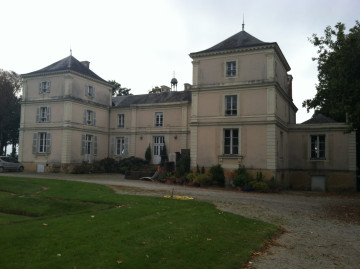The Cellar: Loire & More Day 7
Saturday, October 11, 2014
Day #7 – Bonnezeaux
I spent all day today with Arnaut Saget from Domaine Saget La Perriere exploring his family’s Estate in Sancerre and Pouilly-Fumé. I need to catch up on my articles however, so I am going to push this review until I get home and tell you about at very special visit I made at Chateau Fesles in Anjou a few days ago.
Chateau Fesles in located in the commune of Thouarcé in the central Anjou region of the Loire Valley. There I met with winemaker Gilles Bigot who has been with the Estate for more than 20 years. While Chateau Fesles produces really good white, rosé and red wines based on Chenin Blanc, Gamay, Grolleau and Cabernet Franc, what the Chateau is really famous for is their sweet ‘Bonnezeaux’ wine made from late harvested Chenin. Bonnezeaux, by the way, is the name of a nearby village, as well as a 300 acre appellation for sweet wines that parts of Chateau Fesles’ acreage lies within.GET THE LATEST BREAKING NEWS HERE -- SIGN UP FOR GOLOCAL FREE DAILY EBLAST
A wine labeled ‘Bonnezeaux’ (pronounced ‘bon-zu’) must be made exclusively from Chenin Blanc. What makes this sweet wine especially interesting is the way it is made as the producer must use late harvested grapes that have been infected with a rot called botrytis. Botrytis is a rot that occurs naturally, but only under very specific climatic conditions - hence in very few places. Basically, what botrytis does is it penetrates the skin of the grape causing the water inside to escape/evaporate. This turns the grape into a sort of raisin on the vine concentrating the sugars in the process. After the grapes have reached optimal levels of ‘botrytis’ the grapes must be harvested by hand.
After a careful sorting operation the gently pressed juice is first barrel fermented then aged in 50% oak and 50% Acacia barrels for 10 months. After that, the wines are blended together in stainless steel tanks and allowed to settle for 6 months. After being bottled the wine is left to rest for an additional 24 months before being released.
As you can imagine the sugar, as well as the previously discussed inherent acidity of Chenin Blanc, acts as preservatives which allow this wine to age for decades. I was fortunate enough to experience this for myself as Gilles had me sample Chateau Fesles’ Bonnezeaux from 1999 to a tank sample of their 2013 vintage which had just been blended together in stainless steel tanks one week ago.
While there was much hype about the powerful 2000, 2005 and, more recently, the 2010 vintage, I ended up preferring the 2007 vintage. While all these wines display explosive, concentrated flavors of ripe peach, fig and candied lemon, the relatively cool season of 2007 provided just the appropriate amount of acidity for my palate.
Steffen Rasch is a Certified Sommelier and Specialist of Wine. Feel free to email him at [email protected] with any wine-related question or learn about wine in person by signing up for one of his tastings through the Providence Wine Academy.
Related Articles
- The Cellar: Delicious Wine from France’s Loire Valley
- The Cellar: Discoveries from France’s Loire Valley
- The Cellar: Loire & More Day 1
- The Cellar: Loire & More Day 2
- The Cellar: Loire & More Day 3
- The Cellar: Loire & More Day 6
- The Cellar: Loire & More Day 5
- The Cellar: Loire & More Day 4
- The Cellar: The Other Pinot
- The Cellar: 3rd Annual Wine, Cheese and Chocolate Market
- The Cellar: Aged Rioja and a Great Chardonnay
- The Cellar: The Making of a World Class Wine
- The Cellar: For the Love of Cabernet (Franc)
- The Cellar: Pouilly-Fumé—the other Sauvignon Blanc
- The Cellar: Discover Tavel
- The Cellar: Great Spring Whites—Round Pond & Red Newt
- The Cellar: Berlucchi + Avignonesi
- The Cellar: Wines of South America
- The Cellar: The Wonders of Gewürz
- The Cellar: Expand Your Palate
- The Cellar: New Zealand Pinot Noir
- The Cellar: 2 Outstanding (unusual) Reds
- The Cellar: Late Summer Values
- The Cellar: The King of Wines
- The Cellar: Last Chance for Rosé
- The Cellar: Two Wines You Should Always Have On Hand







